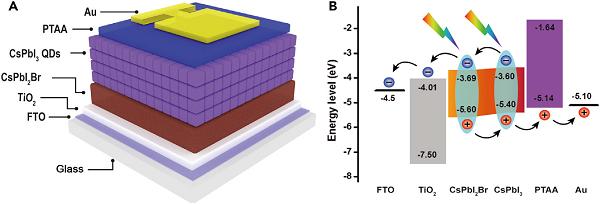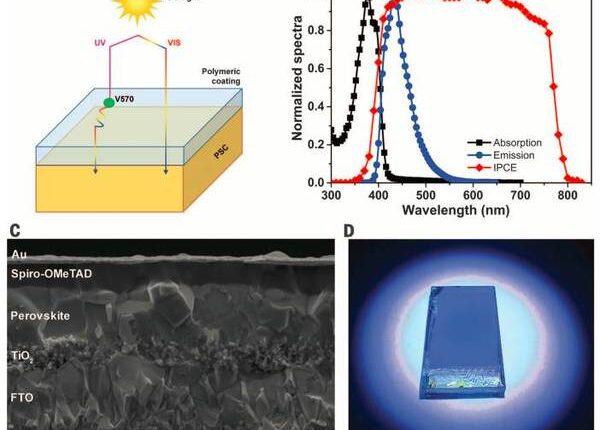Scientists from the Energy Research Institute of Nanyang Technological University in Singapore have developed a co-evaporated perovskite solar cell efficiency with strong power conversion efficiency and good thermal stability.
Perovskite Solar Cell Efficiency 2021, Researcher Annalisa Bruno say : “These batteries can be used in a variety of applications. In our research, we have demonstrated for the first time the versatility of the thermal evaporation process in customizing perovskite absorbers for different architectures.” It adopts a “pin” layout and relies on a co-evaporated MAPbI 3 film.
The co-evaporation Perovskite Solar Cell Efficiency process used by the researchers allows the production of graded, customizable perovskite layers without the need for additional layers or additional passivation steps. During the evaporation process, the background pressure will slowly decrease to reach the required Fermi level, which ensures the effective conversion of radiant energy to electrochemical energy.
During the co-evaporation process of forming the battery perovskite absorber, controlling and monitoring the growth and composition of lead iodide (PbI2) and methyl ammonium iodide (MAI) is the main challenge of this manufacturing step. They tested different electron and hole transport materials (HTM) on the battery. The best-performing battery has an HTM made of [2-(3,6-dimethoxy-9H-carbazol-9-yl)ethyl]phosphonic acid, which is also called MeO-2PACz.
The optimal battery based on self-assembled monolayer (SAM) MeO-2PACz achieved the record efficiency of 20.6% described by the researchers, and based on 2,2,7,7-tetra(N,N-di-p-tolyl ) Amino-9,9-spirobifluorene (spiro-TTB) and poly(triarylamine) (PTAA) are used as two different batteries of HTM, both Perovskite Solar Cell Efficiency of 20.3%.
The research team revealed that “the power conversion efficiency distribution of perovskite solar cells using three different hole transport layers (HTL) is very narrow, which highlights the good repeatability of these co-evaporated cells.” When spiro-TTB When enlarged to the size of 1cm2 and 1.96cm2, its efficiency reached 19.1% and 17.2%, respectively.
The researchers said: “These unencapsulated co-evaporated pin perovskite solar cells exhibit significant long-term stability, and can still maintain 90% of their initial power conversion efficiency after being stored for more than 1,000 hours at room temperature.”
According to Bruno, these large-area cells are by far the most effective of co-evaporated perovskite solar cells of this size. It is said that these batteries also have considerable thermal stability because they maintain an initial efficiency of more than 80% after heat aging at 85 degrees Celsius for 500 hours.
She commented, “In view of the development of thermal co-evaporation perovskite batteries in the past few years , we hope to see these batteries reach commercialization in the next few years.”
Scientists recently published in Advanced Functional Materials (Advanced Functional Materials) “Co-evaporated MAPbI3 with hierarchical Fermi layer can achieve high-performance, scalable and flexible pin perovskite solar cells” article describes this battery and related manufacturing technology.

Organic-inorganic hybrid perovskite materials have shown great potential in solar cells, light-emitting diodes, photoelectric detection, resistance memory and other fields due to their strong light absorption rate, high mobility, long carrier life, adjustable band gap and various processing methods.
Especially in the field of solar cells, the energy conversion efficiency of solar cells based on organic-inorganic Perovskite Solar Cell Efficiency has increased from 3.8% to 25.5% since it was first reported in 2009.
However, due to the existence of organic ions (MA+, FA+, etc.), the stability of organic ions has always been the focus of the commercial development of photovoltaic devices.
How to improve the stability of perovskite thin film materials while maintaining excellent photoelectric properties is a key technical problem to be solved urgently.
Professor Chang Jingjing’s research group of Academician Hao Yue of Xi’an University of Electronic Science and Technology achieved efficient stabilization of perovskite solar cell devices by using the interface passivation of perovskite thin film co-surfactant (Triton X-100) to modify PC61BM.
The research shows that by using fluoride molecules (CF3-PEABr) to modify the perovskite interface to form low-dimensional perovskite, the interface defect state can be effectively passivated and the crystalline quality of the film can be improved “Perovskite Solar Cell Efficiency”.
Will Perovskite Solar Cell Efficiency increase more within 2022 ?

